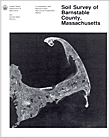The following is a map unit description from the "Soil Survey of Barnstable County, Massachusetts (Fletcher, 1993)"

ScA-Scitico silt loam, 0 to 3 percent slopes. This very deep, nearly level, poorly drained soil is in depressions, at the base of swales, and in low areas of glacial lake deposits that border streams, ponds, and swamps. It makes up about 0.1 percent (320 acres) of the survey area. It is mapped mainly in the PlymouthEastchop-Carver-Boxford general soil map unit. Areas are irregular in shape and range from 5 to 140 acres in size.
Typically, the surface is covered with an organic layer. This layer is about 2 inches of loose, undecomposed pine needles, leaves, and twigs and 3 inches of black, partly decomposed and well decomposed organic material. The surface layer is very dark grayish brown, friable silt loam about 2 inches thick. The subsoil is mottled, friable silty clay loam 21 inches thick. The upper part is grayish brown, and the lower part is gray. The substratum to a depth of 65 inches or more is dark grayish brown, mottled, firm silty clay loam.
Included with this soil in mapping are small areas of Boxford, Maybid, and Walpole soils and some areas where the soil is underlain by sandy and gravelly material below a depth of 65 inches. Included soils make up about 25 percent of this unit.
Permeability is moderately slow or slow in the subsoil of the Scitico soil and slow or very slow in the substratum. Available water capacity is high. The seasonal high water table is at or near the surface in fall, winter, and spring and after periods of heavy precipitation.
Most areas are used as woodland or support shrubby vegetation.
Because of the wetness, this soil is very poorly suited to many of the crops commonly grown in the county. A surface drainage system is needed for good yields. Growing cover crops, incorporating grasses and legumes into the crop rotation, and mixing manure and crop residue into the plow layer improve tilth.
This soil is poorly suited to hay and pasture because of the wetness. The suitability can be improved by installing a drainage system and planting water-tolerant species. The main management objective is the prevention of overgrazing, which reduces the hardiness and density of desirable plants. Proper stocking rates, timely grazing, and restricted use during wet periods help to maintain plant density and minimize surface compaction.
This soil is poorly suited to woodland because of the wetness and a high seedling mortality rate. Optimal tree growth is unlikely, and many seedlings do not survive. Because of low soil strength, the use of equipment should be limited to periods when the soil is dry or frozen. Onsite investigation may identify areas where trees can be planted if special management is applied. The most common trees are red maple, tupelo, and pitch pine.
The seasonal high water table limits the use of this soil as a site for dwellings and for septic tank absorption fields. The slow or very slow permeability in the substratum also is a limitation on sites for septic tank absorption fields. Alternative sites should be selected. In areas where the soil is underlain by sandy and gravelly material, excavation to this material helps to overcome the restricted permeability.